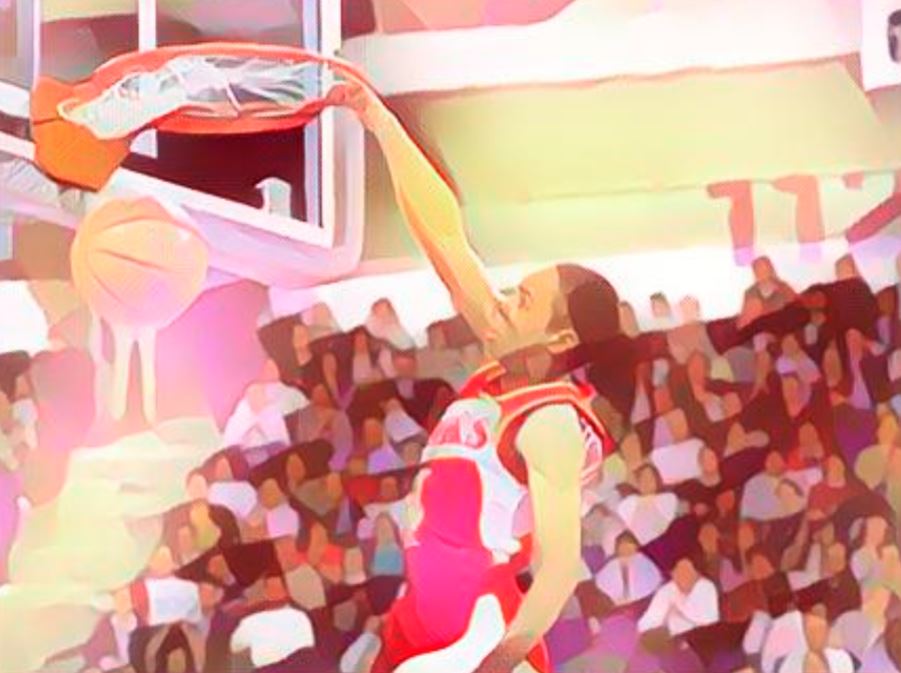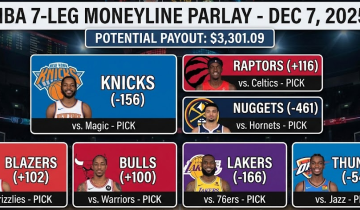How tall do you really need to be in order to dunk a basketball?
Hey there! If you’re wondering how tall you need to be to dunk, the short answer is 5’2″ or taller. That’s because the shortest man to dunk that we know of was 5’2″. So, if a 5’2 guy like Spudd Webb could do it, then you should be able to too if you’re the same height or taller.
But there’s more to it than just height. Sure you can grow taller and maybe try some supplements, but there is more to it. The answer is a bit complicated because there are actually a few factors to consider. These include:
- Your height
- Your standing reach
- Your vertical jump
- The height of the rim
If you’re playing on a regulation court, then the height of the rim will be 10 feet. The good news is that, no matter what height you are, you have a chance to dunk because there’s one variable you can change. The bad news is that, unless you’re still growing, two of the three variables are fixed and won’t change.
Your height is self-explanatory. You measure it with shoes on since you’ll be playing with shoes. Just keep in mind that NBA players’ heights can vary by 1.25 to 1.5 inches with and without shoes. You can also wear insoles to add some extra height.
Standing reach is how high you can reach from a standstill position. This has a lot to do with your wingspan and some people naturally have longer or shorter arms. It’s measured by standing flat-footed on the ground and reaching straight up into the air.
So, those are the two most important factors to consider when thinking about how tall you need to be to dunk. Of course, your vertical jump is also important, but we’ll talk more about that in the next section.
Dunking is one of the most exciting and impressive aspects of basketball, and it is a skill that many players strive to perfect. Height is often considered to be an advantage in dunking, but it is not the only factor that determines a player’s ability to dunk. In this article, we will explore the relationship between height and dunking ability in the NBA and the role of other factors such as vertical leap, arm length, and strength.
What exercises are good for dunking?
There are 7 big time exercises that can help improve your vertical jump and ability to dunk a basketball. Here are some of the most effective exercises for improving your dunking skills:
- Squats: Squats are a great exercise for building strength in your legs and lower body, which is crucial for jumping ability.
- Box jumps: Box jumps are a plyometric exercise that helps build explosive power in your legs, improving your ability to jump higher.
- Deadlifts: Deadlifts are a full-body strength exercise that can help improve your leg and hip strength, making it easier for you to jump higher.
- Lunges: Lunges are another great lower body exercise that can help build strength and power in your legs.
- Calf raises: Calf raises are a great exercise for building strength in your calf muscles, which play an important role in jumping ability.
- Jump rope: Jump rope is a great cardiovascular exercise that can help improve your overall leg and foot speed, making it easier for you to jump higher.
- Plyometric drills: Plyometric drills, such as jump training and depth jumps, can help improve your explosive power and jumping ability.
It’s important to note that these exercises should be performed with proper form and under the guidance of a qualified coach or trainer. Additionally, it’s important to include a variety of exercises in your training routine to target different muscle groups and improve your overall athletic performance.
Average Height of NBA Dunkers
The average height of NBA players is around 6 feet 7 inches, and many of the league’s top dunkers are well above this average height. For example, players like LeBron James (6 feet 8 inches), Blake Griffin (6 feet 10 inches), and Dwight Howard (6 feet 10 inches) are all known for their powerful and athletic dunks. However, there are also many players who are below the average height and are still able to dunk, including players like Spud Webb (5 feet 7 inches) and Nate Robinson (5 feet 9 inches).
Height and Wingspan Relationship in Basketball
In the world of basketball, height and wingspan are two important physical attributes that can greatly impact a player’s performance on the court. While height is often the first thing people notice about a basketball player, wingspan can also have a significant impact on a player’s abilities. In this article, we will examine the relationship between height and wingspan in basketball and how they can affect a player’s game.
Height Height is a well-known factor in basketball and is often used to determine the position a player will play. For example, taller players are often expected to play in the post, while shorter players are expected to play on the perimeter. However, height is not just important for determining position, it can also have a major impact on a player’s abilities. Taller players have a higher reach, which can make it easier to grab rebounds and block shots. Additionally, taller players have more leverage and can overpower smaller players in the paint.
Wingspan Wingspan is often overlooked, but it can have just as much impact on a player’s game as height. Wingspan is defined as the distance from the tip of one middle finger to the other when a player’s arms are outstretched. This measurement can be longer or shorter than a player’s height, and it can greatly impact their abilities on the court. A longer wingspan can make it easier for a player to grab rebounds, block shots, and make steals. Additionally, a longer wingspan can make it more difficult for opponents to get around a player and score.
The Relationship So, what is the relationship between height and wingspan in basketball? While height is an important factor, wingspan can have just as much impact on a player’s abilities. In fact, many players with a longer wingspan than their height are able to make up for their lack of height with their longer reach. This can be especially beneficial for smaller players who may struggle to compete with taller players in the paint.
However, height and wingspan are not the only factors that impact a player’s game. Vertical jump, speed, agility, and strength are also important attributes that can greatly impact a player’s abilities on the court.
Conclusion In conclusion, height and wingspan are two important physical attributes in basketball that can greatly impact a player’s performance on the court. While height is often the first thing people notice, wingspan can also have a significant impact on a player’s abilities. The relationship between height and wingspan is complex, but understanding it can help players and coaches better understand the importance of both attributes. Whether you’re a player or a fan, it’s important to understand the impact that height and wingspan can have on the game of basketball.
Correlation between Height and Dunking Ability
While height can be an advantage in dunking, it is not the only factor that determines a player’s ability to dunk. In fact, other factors such as vertical leap, arm length, and strength can play a more significant role in a player’s dunking ability than height. A player with a higher vertical leap and longer arms can dunk even if they are not as tall as other players, and a player with excellent strength and power can dunk despite being shorter than average.
Importance of Vertical Leap in Dunking
Vertical leap is the measurement of a player’s ability to jump straight up and reach a high point. It is an important factor in dunking because it determines how high a player can jump and how much control they have over the ball when they are in the air. A higher vertical leap allows a player to reach higher and dunk with more control, even if they are not as tall as other players.
Basically, height is an advantage in dunking, but it is not the only factor that determines a player’s ability to dunk. Vertical leap, arm length, and strength also play a role in dunking ability, and many players have developed their dunking skills through training and conditioning. Whether you are tall or short, there are ways to improve your dunking ability and become a more powerful and athletic dunker.
The Role of Arm Length and Wingspan in Dunking
Arm length and wingspan play an important role in dunking ability, as they determine how high a player can reach and how much control they have over the ball when they are in the air. A player with longer arms and wingspan can reach higher and dunk with more control, even if they are not as tall as other players. Additionally, longer arms can also provide an advantage on the defensive end, as they make it easier for a player to contest shots and make steals.
Arm length and wingspan can be an advantage in dunking, and they are just one of the many factors that contribute to a player’s overall ability to play the game. While height is often considered to be an advantage in dunking, players with longer arms and wingspan can still be dominant dunkers and make an impact on the court.
How to Increase Your Vertical Leap to Dunk if you’re tall or not
Dunking is a highly sought-after skill in basketball, and many players strive to perfect their dunking ability. While height is often considered to be an advantage in dunking, vertical leap is actually a more significant factor in determining a player’s ability to dunk. In this section, we will explore the steps that players can take to increase their vertical leap and improve their dunking ability by way of exercise. If you’re looking to vitamins and related, please check out our guide to basketball supplements here.
Statistics on Vertical Leap
The average vertical leap for a male basketball player is around 28 inches, while the average for a female player is around 20 inches. However, many professional basketball players have vertical leaps that are much higher, and some of the best dunkers in the league have vertical leaps of 40 inches or more.
Factors that Affect Vertical Leap
There are several factors that can affect a player’s vertical leap, including genetics, body weight, strength, and training. Genetics play a role in determining a player’s natural jumping ability, but body weight, strength, and training can all be improved through hard work and dedication.
5 Tips for Improving Vertical Leap to Dunk, no matter how tall you are!
Here are some tips for improving your vertical leap and increasing your dunking ability:
- Strength training: Building strength in your legs and core can help you jump higher and increase your vertical leap. Squats, lunges, and jump training exercises are all effective ways to build strength and improve your jumping ability.
- Body weight training: Losing weight and reducing body fat can improve your jumping ability, as it will make it easier for your muscles to generate explosive power.
- Plyometric training: Plyometric exercises, such as box jumps, can help you improve your jumping ability and increase your vertical leap. These exercises train your muscles to generate explosive power and improve your jumping ability.
- Stretching: Stretching is important for improving your jumping ability, as it helps to increase your flexibility and reduce your risk of injury.
- Consistency: Improving your vertical leap takes time and dedication, and it is important to train consistently to see results. Incorporating these tips into your training regimen and practicing regularly will help you achieve your goal of dunking.
Increasing your vertical leap is the key to improving your dunking ability. By incorporating strength training, body weight training, plyometric training, stretching, and consistency into your training regimen, you can achieve your goal of dunking and become a more explosive and athletic player on the court.
Short Players Who Can Dunk: An Analysis of NBA Players
Height is often considered to be an advantage in dunking, but it is not the only factor that determines a player’s ability to dunk. In fact, there are many short players who have overcome their height disadvantage and become dominant dunkers in the NBA. In this article, we will explore the careers of some of the most successful short players in the NBA and examine the factors that have allowed them to become successful dunkers.
Spud Webb
Spud Webb is one of the most famous short players in NBA history, and he is best known for winning the 1986 NBA Slam Dunk Contest. Standing at just 5 feet 7 inches, Webb was one of the shortest players in the league, but he was also one of the most athletic and explosive dunkers. He had a vertical leap of 44 inches and was known for his powerful and creative dunks.
Nate Robinson
Nate Robinson is another short player who has made a name for himself as a dunker in the NBA. Standing at 5 feet 9 inches, Robinson has won the NBA Slam Dunk Contest three times and is known for his high-flying and athletic dunks. He has a vertical leap of 44 inches and has become one of the most successful short players in NBA history.
Isaiah Thomas
Isaiah Thomas is a former All-Star point guard who played in the NBA for over a decade. Standing at just 5 feet 9 inches, Thomas was one of the shortest players in the league, but he was also one of the most talented and successful players of his generation. He was known for his scoring ability and his clutch performances in big games, and he was also a successful dunker despite his height.
Height is not a determining factor in a player’s ability to dunk, and there are many short players who have become successful dunkers in the NBA. Players like Spud Webb, Nate Robinson, and Isaiah Thomas have overcome their height disadvantage and become dominant players in the league through their athleticism, explosive power, and vertical leap. Whether you are tall or short, with the right training and dedication, you can become a successful dunker and make an impact on the court.
The Benefits of Dunking for Basketball Players
Introduction Dunking is one of the most exciting and impressive skills in basketball, and it has many benefits for players at all levels of the game. From improving your jumping ability and increasing your vertical leap, to enhancing your overall athleticism and gaining confidence on the court, dunking can provide numerous benefits for basketball players. In this article, we will explore some of the key benefits of dunking and why it is an important skill to master.
- Improves Jumping Ability and Vertical Leap – Dunking requires a high level of jumping ability and explosive power, and practicing dunking can help you improve your jumping ability and increase your vertical leap. By training your muscles to generate more power and height, you can become a more athletic and explosive player on the court.
- Enhances Athleticism – Dunking is a highly athletic skill that requires coordination, balance, and body control. By practicing dunking, you can improve your overall athleticism and become a more versatile and dynamic player on the court.
- Increases Confidence – Dunking can be a confidence-booster for basketball players, and it can help you feel more confident on the court. By mastering the skill of dunking, you can gain a sense of pride and accomplishment, and you can use that confidence to perform better in games.
- Adds Variety to Your Game – Dunking can add variety to your game and make you a more versatile player on the court. By incorporating different types of dunks into your game, you can become a more dynamic player and make it more difficult for defenders to guard you.
Dunking has many benefits for basketball players, including improving your jumping ability and vertical leap, enhancing your overall athleticism, increasing your confidence, and adding variety to your game. Whether you are a beginner or an experienced player, dunking is an important skill to master, and it can help you become a better player on the court.
The Risks of Dunking for Basketball Players
Dunking is a highly athletic and impressive skill in basketball, but it also comes with certain risks and dangers. From the risk of injury to the potential for damaging the rim or the court, dunking can have negative consequences for players and the game itself. In this article, we will explore some of the key risks associated with dunking and why it is important to practice safe and responsible dunking.
- Risk of Injury Dunking can be a physically demanding skill, and it puts a lot of stress on your legs, knees, and back. If you do not warm up properly or if you attempt a dunk that is too difficult for your skill level, you may be at risk of injury.
- Potential for Damaging the Rim or the Court Dunking can be hard on the rim and the court, and if you dunk too aggressively, you may cause damage to the equipment. This can result in costly repairs and maintenance, and it can also be a safety hazard for other players.
- Unsportsmanlike Conduct Dunking can also be considered unsportsmanlike if you dunk too aggressively or if you showboat after making a dunk. This can lead to technical fouls and other penalties, and it can also harm the reputation of the game and the players involved.
Dunking is a valuable skill in basketball, but it also comes with certain risks and dangers. It is important to practice safe and responsible dunking, and to be mindful of the potential consequences of your actions. By following proper technique and respecting the equipment and the game, you can enjoy the benefits of dunking.
The History of Dunking in the NBA
Introduction Dunking is one of the most exciting and iconic skills in basketball, and it has a rich history in the NBA. From its early origins in the 1950s and 1960s, to its evolution into a showcase of athletic excellence and creativity, dunking has played a significant role in the development and popularity of the NBA. In this article, we will explore the history of dunking in the NBA and the key moments and players that have shaped this skill over the years.
- The Origins of Dunking in the NBA Dunking first became popular in the NBA in the 1950s and 1960s, with players like George Mikan, Dolph Schayes, and Bill Russell leading the way. These players were known for their powerful and athletic dunks, and they helped establish dunking as an important part of the game.
- The Emergence of Dominant Dunkers in the 1970s and 1980s The 1970s and 1980s saw the emergence of dominant dunkers in the NBA, with players like Julius Erving, David Thompson, and Darryl Dawkins showcasing their incredible athletic abilities and creativity with their dunks. These players helped popularize dunking and made it an integral part of the game.
- The Rise of the Slam Dunk Contest The Slam Dunk Contest was first introduced in the NBA All-Star Weekend in 1984, and it quickly became one of the most popular and exciting events of the year. With players like Michael Jordan, Dominique Wilkins, and Vince Carter showcasing their incredible dunking skills, the Slam Dunk Contest has become a showcase of athletic excellence and creativity.
- The Evolution of Dunking in the Modern NBA In the modern NBA, dunking has continued to evolve and become an even more important part of the game. With players like LeBron James, Giannis Antetokounmpo, and Zion Williamson showcasing their incredible athleticism and creativity with their dunks, the skill of dunking has become a key part of the NBA experience for fans and players alike.
In a nutshell, dunking has a rich history in the NBA, and it has played a significant role in the development and popularity of the league. From its early origins in the 1950s and 1960s, to its evolution into a showcase of athletic excellence and creativity, dunking has become an iconic skill in the NBA and a key part of the game!
The Best Dunkers in NBA History
Introduction Dunking is one of the most exciting and impressive skills in basketball, and there have been many great dunkers in NBA history. From dominant big men to explosive guards, the NBA has seen its fair share of incredible dunkers over the years. In this article, we will explore some of the best dunkers in NBA history and examine their careers and achievements.
- Michael Jordan is widely considered to be one of the best dunkers in NBA history, and he is also one of the greatest players of all time. With his powerful and athletic dunks, Jordan helped popularize dunking and make it an integral part of the game. He won the Slam Dunk Contest in 1987, and he is remembered for his incredible aerial displays and clutch dunks in big games.
- Julius Erving, also known as Dr. J, is one of the greatest dunkers in NBA history and one of the pioneers of the modern game. With his powerful and graceful dunks, Erving helped popularize dunking and make it an important part of the game. He won three NBA titles and was inducted into the Hall of Fame in 1993.
- Dominique Wilkins, also known as the “Human Highlight Reel,” is one of the best dunkers in NBA history. With his explosive athleticism and creativity, Wilkins was a fan favorite and a dominant force in the league. He won the Slam Dunk Contest in 1985 and 1990, and he was inducted into the Hall of Fame in 2006.
- Vince Carter Vince Carter is one of the most athletic and creative dunkers in NBA history. With his incredible aerial displays and clutch dunks, Carter was a fan favorite and a dominant force in the league. He won the Slam Dunk Contest in 2000, and he is remembered for his incredible athleticism and clutch dunks in big games.
- LeBron James LeBron James is one of the most dominant players in NBA history, and he is also an incredible dunker. With his powerful and athletic dunks, James has become one of the most exciting players to watch in the league. He has won four NBA titles and has been named to the All-Star team 17 times. Read about LeBron James supplements intake here.





